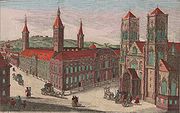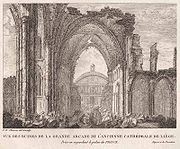
St. Lambert's Cathedral, Liège
Encyclopedia
- for the present cathedral of Liège see Liège CathedralLiège CathedralLiège Cathedral, otherwise St. Paul's Cathedral, Liège, in Liège, Belgium, is the seat of the Bishopric of Liège.-St. Paul's Cathedral:...

Cathedral
A cathedral is a Christian church that contains the seat of a bishop...
of Liège
Liège
Liège is a major city and municipality of Belgium located in the province of Liège, of which it is the economic capital, in Wallonia, the French-speaking region of Belgium....
, Belgium
Belgium
Belgium , officially the Kingdom of Belgium, is a federal state in Western Europe. It is a founding member of the European Union and hosts the EU's headquarters, and those of several other major international organisations such as NATO.Belgium is also a member of, or affiliated to, many...
, until 1794, when its destruction began. This enormous Gothic
Gothic architecture
Gothic architecture is a style of architecture that flourished during the high and late medieval period. It evolved from Romanesque architecture and was succeeded by Renaissance architecture....
cathedral, dedicated to Saint Lambert of Maastricht, occupied the site of the present Place Saint-Lambert in the centre of Liège.
History
Saint Lambert, bishop of Maastricht, was assassinated in Liège about 705, and was initially buried in MaastrichtMaastricht
Maastricht is situated on both sides of the Meuse river in the south-eastern part of the Netherlands, on the Belgian border and near the German border...
. The site of his martyrdom became a place of pilgrimage, and his successor, Saint Hubert, returned the body and reburied it there. Shortly afterwards the episcopal seat was transferred from Maastricht to Liège, and Lambert's shrine became a cathedral.
Several structures succeeded each other on the site. The first was a martyr's shrine or mausoleum (martyrium), commissioned by Saint Hubert. Unusually it was oriented to the west, which may account for the existence of a west choir in subsequent cathedral buildings. Two cathedrals followed. The first, built towards the end of the 8th century, was in Carolingian
Carolingian architecture
Carolingian architecture is the style of north European Pre-Romanesque architecture belonging to the period of the Carolingian Renaissance of the late 8th and 9th centuries, when the Carolingian family dominated west European politics...
style.
In 978 Bishop Notger
Notker of Liège
Notker of Liège was a Benedictine monk, bishop and first prince-bishop of the Bishopric of Liège with a capital Liège/Lüttich, ....
installed a chapter
Cathedral chapter
In accordance with canon law, a cathedral chapter is a college of clerics formed to advise a bishop and, in the case of a vacancy of the episcopal see in some countries, to govern the diocese in his stead. These councils are made up of canons and dignitaries; in the Roman Catholic church their...
of sixty canon
Canon (priest)
A canon is a priest or minister who is a member of certain bodies of the Christian clergy subject to an ecclesiastical rule ....
s. He then built a new church from around the year 1000, in Ottonian
Ottonian architecture
Ottonian Architecture is an architectural style which evolved during the reign of Emperor Otto the Great . The style was found in Germany and lasted from the mid 10th century until the mid 11th century....
style, with a special crypt
Crypt
In architecture, a crypt is a stone chamber or vault beneath the floor of a burial vault possibly containing sarcophagi, coffins or relics....
for the relics of the martyred saint. The architecture was that of the Holy Roman Empire
Holy Roman Empire
The Holy Roman Empire was a realm that existed from 962 to 1806 in Central Europe.It was ruled by the Holy Roman Emperor. Its character changed during the Middle Ages and the Early Modern period, when the power of the emperor gradually weakened in favour of the princes...
. The new cathedral had a massive westwork
Westwork
A westwork is the monumental, west-facing entrance section of a Carolingian, Ottonian, or Romanesque church. The exterior consists of multiple stories between two towers. The interior includes an entrance vestibule, a chapel, and a series of galleries overlooking the nave...
, two choirs at opposite ends, two transept
Transept
For the periodical go to The Transept.A transept is a transverse section, of any building, which lies across the main body of the building. In Christian churches, a transept is an area set crosswise to the nave in a cruciform building in Romanesque and Gothic Christian church architecture...
s, each with a tower over the crossing, adding to the monumentality of the structure, and a cloister
Cloister
A cloister is a rectangular open space surrounded by covered walks or open galleries, with open arcades on the inner side, running along the walls of buildings and forming a quadrangle or garth...
at the east end. It is noticeable from the groundplan that the entrances were located in the north and south sides of the building, and not along the east-west axis.
Many alterations were made to it during the decades 1140-1180.
The disgraced and excommunicated Emperor Henry IV
Henry IV, Holy Roman Emperor
Henry IV was King of the Romans from 1056 and Holy Roman Emperor from 1084 until his forced abdication in 1105. He was the third emperor of the Salian dynasty and one of the most powerful and important figures of the 11th century...
, who died on 7 August 1106, was buried here by the Prince-Bishop Otbert
Otbert of Liège
Otbert of Liège was bishop of Liège at the end of the eleventh century . He was a major figure in the financing of the First Crusade, and an expansionist....
, after the entrails and heart had been removed. The German bishops protested and declared that the cathedral would be considered contaminated as long as the body remained there. Emperor Henry V
Henry V, Holy Roman Emperor
Henry V was King of Germany and Holy Roman Emperor , the fourth and last ruler of the Salian dynasty. Henry's reign coincided with the final phase of the great Investiture Controversy, which had pitted pope against emperor...
therefore had his father's remains disinterred and transferred to Speyer Cathedral
Speyer Cathedral
The Speyer Cathedral, officially the Imperial Cathedral Basilica of the Assumption and St Stephen, in Latin: Domus sanctae Mariae Spirae in Speyer, Germany, is the seat of the Roman Catholic Bishop of Speyer and is suffragan to the Archdiocese of Bamberg. The cathedral, which is dedicated to St...
, on 15 August 1106.
During the night of 28/29 April 1185 a violent fire broke out in one of the houses next to the cloisters, to which it immediately spread, and from there to the rest of the cathedral, which was destroyed. Reconstruction began the very next day, in the Gothic
Gothic architecture
Gothic architecture is a style of architecture that flourished during the high and late medieval period. It evolved from Romanesque architecture and was succeeded by Renaissance architecture....
style, making extensive use of the previous foundations. Part of the cathedral had been restored by 1189, when the Archbishop of Cologne visited in order to reconsecrate the church. In 1197, the relics of Saint Lambert, which had been in safe storage since the fire, were reinstalled in the new building.
However, the reconstruction was far from complete, for lack of funds. Processions criss-crossed the diocese in an effort to raise the necessary money. In the middle of the 13th century Pope Innocent IV
Pope Innocent IV
Pope Innocent IV , born Sinibaldo Fieschi, was pope from June 25, 1243 until his death in 1254.-Early life:...
granted indulgences to anyone who helped with the rebuilding of the cathedral.
From 1391, work started on a tower 135 metres high, to the west of the south arm of the eastern transept, the belltower of which was the same height as the hill of the citadel, and for the rest of its existence was a landmark for all who approached the city. Its completion in 1433 marked the end of the major works.
St. Lambert's Cathedral measured 96 metres in length (or 173 metres including the cloisters). With the side chapels its breadth was 37 metres. The height to the top of the ceiling vault was some 30 metres. In style, if not in size, it was comparable to the cathedral of Notre-Dame de Paris. The sandstone towers that characterised the west front were closely related to those of the cathedral of Saints Michael and Gudula in Brussels
Brussels
Brussels , officially the Brussels Region or Brussels-Capital Region , is the capital of Belgium and the de facto capital of the European Union...
, and of the Grote Kerk in Breda
Breda
Breda is a municipality and a city in the southern part of the Netherlands. The name Breda derived from brede Aa and refers to the confluence of the rivers Mark and Aa. As a fortified city, the city was of strategic military and political significance...
, in the Netherlands, as well as of the Basilica of Our Lady in Tongeren.
The archéoforumhttp://www.archeoforumdeliege.be of Liège, situated beneath Place Saint-Lambert, makes it possible to see the ruins of the cathedral, besides the traces of other occupations of the site from the prehistoric period up to the 18th century.
Destruction
In 1794, under the French régime, after the révolution liégeoise, the demolition of the cathedral, agreed the previous year, was put in hand. The Liège revolutionaries considered it a symbol of the power of the Prince-Bishop. Demolition began with the removal of the lead from the roof for use in the manufacture of arms and munitions, under the supervision of a "Commission destructive de la cathédrale". Consideration of the destruction of the great tower began in 1795. In 1803 the western towers were demolished. The site was entirely levelled in 1827, except for a section of masonry from the ancient passage between the cathedral and the bishop's palace, which was still standing in 1929.Once the revolutionary mood had passed, it was necessary to select another church to replace the destroyed cathedral. The collegiate church of St. Paul was selected as being, of those suitable, the closest to the centre of the city, and this became the present Liège Cathedral
Liège Cathedral
Liège Cathedral, otherwise St. Paul's Cathedral, Liège, in Liège, Belgium, is the seat of the Bishopric of Liège.-St. Paul's Cathedral:...
(or St. Paul's Cathedral, Liège). After it had been sensitively modernised, there were transferred to it the numerous treasures that had been saved from the old cathedral - works of gold, ivory, manuscripts, sculptures and reliquaries - which can be seen displayed in the cloisters. The site is maintained today by the Institut du Patrimoine
Institut du Patrimoine
The Institut du Patrimoine wallon is the official public Wallonian institute created by law to protect and spread awareness of Belgian cultural heritage, specifically in Wallonia....
, the institute in charge of cultural heritage
Cultural heritage
Cultural heritage is the legacy of physical artifacts and intangible attributes of a group or society that are inherited from past generations, maintained in the present and bestowed for the benefit of future generations...
protection in Wallonia.
 |

